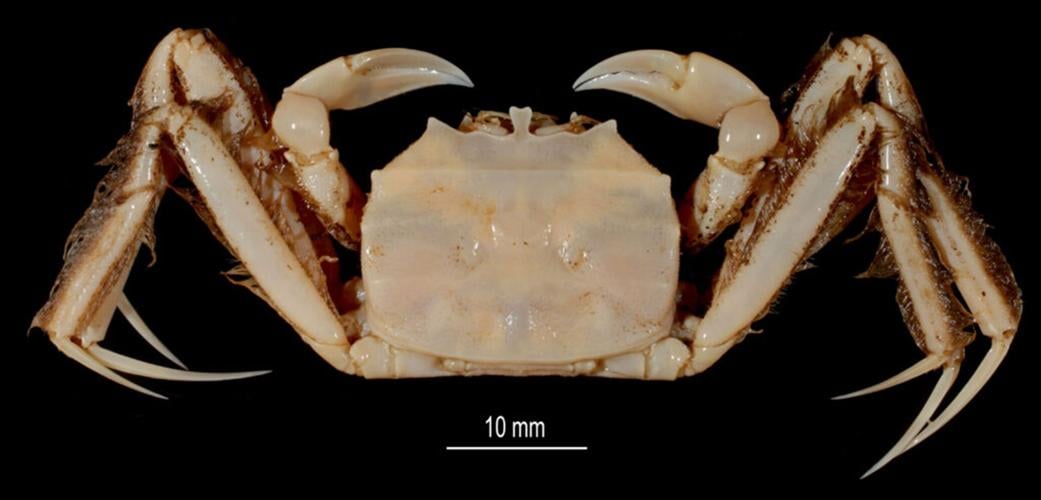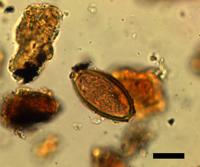A new study of 65-million-year-old crab and shrimp fossils from Lowndes County has yielded multiple species new to science.
One of the new crab species is named after legendary football coach Nick Saban, honoring his achievements for The University of Alabama and the state.
The scientific name of the crab is Costacopluma nicksabani. Lead author Dr. Adiel Klompmaker, curator of paleontology in UA Museums’ Department of Museum Research and Collections, said the species name honors Saban for his six national championships and his dedication to Nick’s Kids Foundation.
Over 1,000 fossil specimens have been discovered already at the Lowndes County site. While Klompmaker has been collecting at the site for the past five years, his colleague George Martin has been going there even longer.
“I’ve been collecting this site for about 15 years, and it is very special to me, primarily because it never stops giving,” said Martin, UA Museums’ Research Associate of Paleontology and avocational (hobby) paleontologist. “It is a small site but has produced several species of decapods and a shark new to science, which is amazing to me.”
The research team also included colleagues from Alabama, Slovakia, Mississippi and Florida. Martin found most of the decapod specimens used in this study.
The Saban crab is the most abundant crab among the newly described decapod crustacean fauna from Lowndes County. Most of the nearly 200 specimens measure up to 15 mm (0.6 inches) in width.
Costacopluma nicksabani lived on or in the muddy sea floor. Specimens of the genus Costacopluma lived from 87–48 million years ago, but members of the same family, Retroplumidae, are still around today.
“The decapod crustacean fauna is quite remarkable and contains, in addition to the Saban crab, seven other species, including another new crab species, two other crabs, a hermit crab and three burrowing shrimps,” Klompmaker said. “We also erected one new crab and one new burrowing shrimp genus to better classify two species in the decapod tree of life.”
Vertebrates (animals with spines) found in Lowndes County include crocodilians, turtles, several species of shark, ray and other fish. Invertebrates, along with the crabs and ghost shrimp, includes a nautiloid and numerous species of oysters, clams, snails and bryozoans, Martin said.
While all non-flying dinosaurs went extinct 66 million years ago after a massive meteorite struck Earth and extensive volcanism, other creatures, such as crabs, survived.
This decapod crustacean fauna lived 600,000–700,000 years after dramatic Cretaceous-Paleogene mass extinction event. Never have as many as eight decapod species been found at a single site in North America so soon – geologically speaking – after this extinction.
A meteorite impact near Mexico and massive volcanic eruptions in India wiped out about 75% of all species on Earth. Major groups such as non-flying dinosaurs, mosasaurs and flying reptiles (pterosaurs) went completely extinct. The hardy decapod crustaceans survived though, and they still flourish in present-day Alabama and elsewhere.
Most fossils from the new study are housed in the UA Museums’ paleontology collection under the care of the Department of Museum Research and Collections. The fossils are available to see during a collections tour upon request.
The scientific paper was published on September 22, 2025, in the freely accessible, international journal Geodiversitas.

















(0) comments
Welcome to the discussion.
Log In
Keep it Clean. Please avoid obscene, vulgar, lewd, racist or sexually-oriented language.
PLEASE TURN OFF YOUR CAPS LOCK.
Don't Threaten. Threats of harming another person will not be tolerated.
Be Truthful. Don't knowingly lie about anyone or anything.
Be Nice. No racism, sexism or any sort of -ism that is degrading to another person.
Be Proactive. Use the 'Report' link on each comment to let us know of abusive posts.
Share with Us. We'd love to hear eyewitness accounts, the history behind an article.